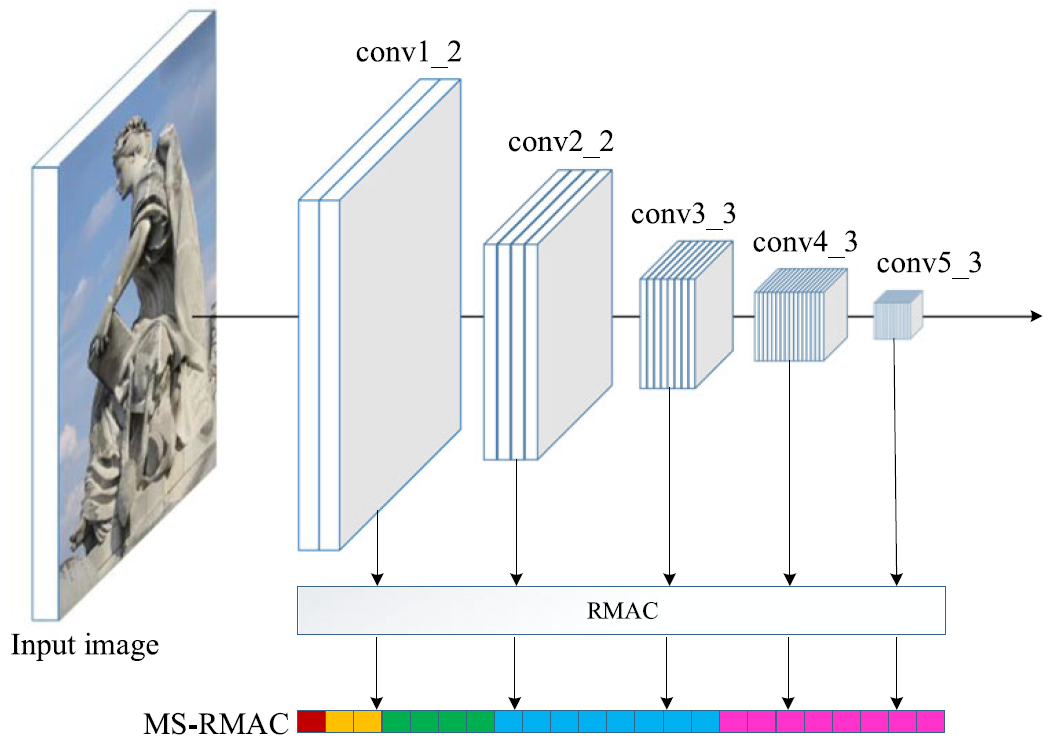“MS-RMAC: Multiscale Regional Maximum Activation of Convolutions for Image Retrieval” improves current Maximum Activation of Convolutions (MAC) feature for image retrieval by using multi-layer and regional MAC. It is published in IEEE Signal Processing Letters in 2017.
Summary
- Problem Statement
- Features from a single convolutional layer are not robust enough for shape deformation, scale variation, and heavy occlusion.
- Proposed Solution
- Extract multiscale (MS) regional maximum activation of convolutions features from different layers of the convolutional neural networks.
- Propose aggregating MS features into a single vector by a parameter-free hedge method for image retrieval.
- Contribution
- MS-RMAC feature is aggregating from MS local convolutional feature maps, which does not require PCA-whitening or specialized fine-tuning on the test dataset and can mimic the ability of SIFT descriptors and CNN category-level features.
- Find that features from higher layers capture more semantic information of objects, and thus perform better than features from lower layers.
- Propose parameter-free weighting schemes that boost the effect of highly active semantic responses and improve retrieval accuracy.
Methodology
MS-RMAC Representation
 Figure 1: Sample regions extracted at three different scales (l = 1, …, 3). The top-left region of each scale (gray colored region) and its neighboring regions toward each direction (dashed borders) are highlighted. We depict the centers of all regions with a red cross.
Figure 1: Sample regions extracted at three different scales (l = 1, …, 3). The top-left region of each scale (gray colored region) and its neighboring regions toward each direction (dashed borders) are highlighted. We depict the centers of all regions with a red cross.
Computing RMAC
As shown in Fig. 1, we uniformly sample regions of width \(2min(W,H)/(l+1)\) at each scale \(l\). Also, the regions are sampled to allow around 40% overlap between consecutive retions. Finally, we sum all regions features into a single vector:
\[F_j=\sum_{i=1}^{N}f_{R_i}=\left[\sum_{i=1}^{N}f_{R_i,1}, \cdots,\sum_{i=1}^{N}f_{R_i,K}\right]^T\]- Notation
- \(j\): the layer number of convolutional feature maps
- \(F_j\): RMAC features
- \(N\): the total region number
Computing MS-RMAC
 Figure 2: Flowchart of the proposed MS-RMAC feature extraction method. Multiple RMAC features from different layers are concatenated into a vector.
Figure 2: Flowchart of the proposed MS-RMAC feature extraction method. Multiple RMAC features from different layers are concatenated into a vector.
Instead of using the final convolutional layer RMAC feature, we propose to use features extracted from multiple convolutional layers.
\[MF = \left[ F_1, \cdots, F_L \right]\]- Notation
- \(MF\): proposed MS-RMAC feature
- \(L\): the total layer number
The image search is then performed by finding the nearest database image to the query and sorting image based on the MS-RMAC feature Euclidean distance, formally
\[d(q,p)=\parallel MF(q)-MF(p)\parallel=\sum^L_{j=1}\alpha_j\parallel F_j(p)-F_j(q)\parallel\]- Notation
- \(d(q,p)\): distance between two images \(p\) and \(q\)
- \(\alpha_j\): weight of different convolutional feature maps, and \(\sum^L_{j=1}\alpha_j=1\)
Hedge Weight for MS-RMAC
The standard parameter-free hedge algorithm is proposed to tackle decision-theoretic online learning problems in a multiexpert multiround setting. And it can be used to calculate the weights \(\alpha_j\).
In round \(t\), the hedge algorithm tries to calculate the weights \(\alpha_t=(\alpha_{1,t}, \cdots, \alpha_{L,t})\). The loss of expert \(j\) is computed as
\[l_{j,t}=S_{j,t}-S_t\]- Notation
- \(S_{j,t}\): the retrieval accuracy only using one layer RMAC feature
- \(S_t\): the retrieval accuracy using all layer RMAC features with the weights in round \(t\).
The standard parameter-free hedge algorithm generates a new weight distribution on all experts by introducing a regret measure defined by
\[r_{j,t}=\overline{l}_{j,t}-l_{j,t}\]where the weighted average loss among all experts is computed as \(\overline{l}_{j,t}=\sum^L_{j=1}\alpha_{j,t}l_{j,t}\).
By minimizing the cumulative regret \(R_{j,t}=\sum^t_{\tau=1}r_{j,\tau}\) in the first \(t\) rounds to any expert \(j\), the weights will be generated.
Experiments

The reason why the proposed MS-RMAC feature performs well is two fold:
- Visual representations using MS hierarchical RMAC features are more effective than single-scale CNN features.
- With CNN features from multiple scale, the proposed feature contains both category-level semantic information and fine-grained details information, which account for appearance changes caused by illumination variation, shape deformation, heavy occlusion, and background clutters.
- The hedge weight method for MS-RMAC* is suitable for boosting the effect of highly active semantic responses and improves image retrieval accuracy.



